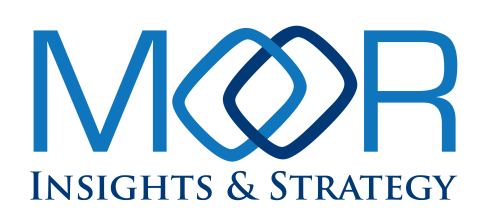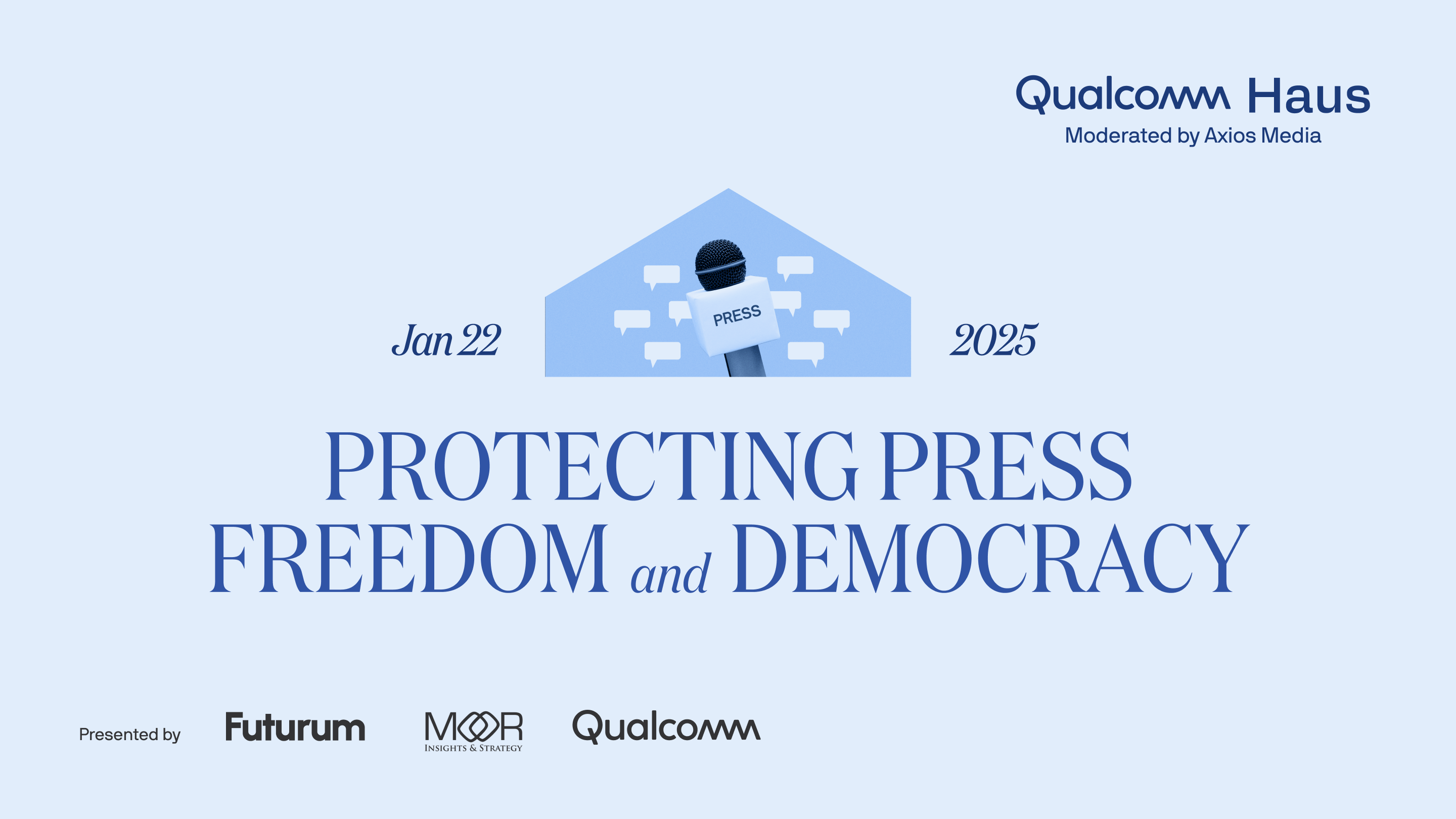
Welcome to this edition of our Weekly Analyst Insights roundup, which features the key insights our analysts have developed based on the past week’s events.
This week I’m in Davos, Switzerland, at the World Economic Forum, meeting with business leaders from around the globe. Moor Insights & Strategy is also co-sponsoring a special session on “Protecting Press Freedom and Democracy,” moderated by Axios Media. While we at MI&S are not journalists, we rely on the technology press for good information, and in turn are often quoted in press outlets as we contribute our own viewpoints to the public discourse on events unfolding in the tech world.

A free press — definitely including social media — is crucial for a thriving tech ecosystem because it ensures that individuals, businesses, and policymakers have access to the information they need to make informed decisions in an increasingly complex technological landscape. We’re proud to support this event as an expression of our deep-rooted commitment to maintaining the freedom of information flow in the tech sector and beyond.
If you or your company executives will be in Davos and you’d like to connect there, please reach out — we’d love to hear from you.
Hope you have a great week,
Patrick Moorhead
———
Our MI&S team published 16 deliverables:
This past week, MI&S analysts have been quoted in the press about Biden’s AI restrictions, Google drones, international malware security issues, intelligent content management, and as usual, AI. Our insights were included in Fierce Network, Yahoo Finance, Ciso2Ciso, The Deccan Herald, and The Straits Times.
MI&S Quick Insights
I think everyone realizes the impacts AI is having on a wide range of business activities. So it should not be a surprise to anyone that The World Economic Forum’s 2025 Future of Jobs Report projects that almost 90% of companies expect that AI will redefine company operations by 2030.
AI is reshaping workplace dynamics. It is expected to create a net increase of 2 million jobs, resulting in 11 million new jobs while displacing 9 million. It is not surprising that the titles with the greatest job growth will be data specialists and AI/ML technologists.
What about people being let go from companies because they don’t have the necessary AI skills? It’s not as bad as expected because 75% of companies plan to upskill current employees for AI collaboration. That shows a focus on adapting to AI advancement instead of replacing staff. And 70% of companies plan to hire people who already have AI expertise. So, most companies will do a little of both actions. Along with those statistics, 50% of businesses say they will reorganize around AI opportunities, and 40% will use workforce reductions to handle AI expansion.
Just reading the news daily will tell you how quickly AI is being adopted. It’s an instance of the old “early bird gets the worm” saying: many companies believe that those who integrate AI fast and first will have a competitive advantage over those that don’t.
The message is clear: AI is coming, and it’s coming fast. It is expected to cause the largest workplace shift in decades. Management should establish AI priorities and get ready to implement them as necessary. Go AI, and go fast.
I think everyone realizes the impacts AI is having on a wide range of business activities. So it should not be a surprise to anyone that The World Economic Forum’s 2025 Future of Jobs Report projects that almost 90% of companies expect that AI will redefine company operations by 2030.
AI is reshaping workplace dynamics. It is expected to create a net increase of 2 million jobs, resulting in 11 million new jobs while displacing 9 million. It is not surprising that the titles with the greatest job growth will be data specialists and AI/ML technologists.
What about people being let go from companies because they don’t have the necessary AI skills? It’s not as bad as expected because 75% of companies plan to upskill current employees for AI collaboration. That shows a focus on adapting to AI advancement instead of replacing staff. And 70% of companies plan to hire people who already have AI expertise. So, most companies will do a little of both actions. Along with those statistics, 50% of businesses say they will reorganize around AI opportunities, and 40% will use workforce reductions to handle AI expansion.
Just reading the news daily will tell you how quickly AI is being adopted. It’s an instance of the old “early bird gets the worm” saying: many companies believe that those who integrate AI fast and first will have a competitive advantage over those that don’t.
The message is clear: AI is coming, and it’s coming fast. It is expected to cause the largest workplace shift in decades. Management should establish AI priorities and get ready to implement them as necessary. Go AI, and go fast.
Salesforce CEO Marc Benioff recently announced a pause in software engineer hiring for the company, suggesting that AI could automate a growing portion of development tasks. This move, likely motivated by potential cost savings and reported productivity gains via Salesforce’s Agentforce AI tool, raises questions about the evolving role of tech jobs and how companies might manage an AI-augmented workforce.
While some praise Salesforce’s innovative approach, many remain cautious about AI’s ability to completely replace human engineers soon. This decision also highlights a key challenge: Could existing departments like IT or HR oversee this new workforce, or will companies create new roles specifically to manage this digital labor?
Salesforce’s strategy serves as an interesting example of how AI might reshape business operations. It remains to be seen whether other companies will adopt similar strategies and how these trends could impact the tech job market over time. This potential shift in the tech landscape underscores the growing potential of AI to reshape industries and redefine workforce needs, with Salesforce highlighting a key strategy for companies promoting AI adoption: demonstrating its ROI through internal cost savings.
What to make of the outgoing administration’s restrictions on AI chips and models? There are so many different angles to consider. However, the sharing of AI model weights and export controls on semiconductors are the two biggies. While the U.S. government has billed this as diffusing AI innovation, it is at the same time restricting innovation of a couple of players that are on the leading edge of AI development.
Does this stifle AI innovation in the United States? I don’t believe so. Perhaps it reshapes some of our collaborative efforts on a global basis, but the semiconductor, hardware, and software ecosystems are going to continue to accelerate at seemingly exponential rates. I just don’t see that slowing down.
Here’s an interesting take: The primary target of these restrictions — China — has been leveraging open-weight models and is using these to try and gain a global footprint. Models like Alibaba’s Qwen have been showing good performance relative to what we have here in the U.S. — especially in multilingual support. And Qwen has found traction in many countries outside of the U.S. and western Europe. Just as Huawei pivoted after its U.S. blacklisting and gained such a strong global footprint in telecom, Alibaba and others can (with Huawei) deliver their own AI factories.
One of the questions we have to ask is whether we are truly protecting the U.S. and its allies with these protectionist measures. Or are we accelerating investments from adversary governments into AI that perhaps pay out in the longer term? It’s a tough question to answer.
The big news of the week was Lenovo’s announcement that it will acquire high-end storage provider Infinidat. While Lenovo has long been strong in the low end of the storage market, it has struggled to find a foothold in the high end of the market. Adding Infinidat to the portfolio solves for this challenge. However, it will take a bit of rationalization across product, marketing, and sales to find success and compete in the enterprise.
I believe that one of the most important assets to consider in this acquisition are the people who have developed, marketed, and sold Infinidat’s solutions to date. The high-end segment they have sold into — and that Lenovo desires to capture — works differently from the volume/transactional markets (commercial enterprise, SMB) where Lenovo has made its mark in storage. I think those same developers and go-to-market professionals will be essential for the success of this business combination. For more details, check out my full analysis of this deal on Forbes.
Active Directory (AD) is a core piece of enterprise IT, as it handles authentication and access to many important IT assets such as apps, databases, and security systems. Unfortunately, its importance also makes it a prime target for cyberattacks. That makes AD recovery after an attack a high priority, but that’s been a function in need of more innovation. “Recovering Active Directory is foundational to maintaining continuous business after a cyberattack, yet traditional methods are too complex and prone to error,” said Pranay Ahlawat, Commvault’s chief technology and AI officer.
To address this issue, Commvault has recently introduced Cloud Backup & Recovery for Active Directory Enterprise Edition, which aims to make AD forest recovery much simpler and more automated. Read more about this in my latest Forbes article.
Microsoft has introduced Microsoft 365 Copilot Chat, a new AI service for businesses that blends free chat features with consumption-based access to AI agents. This offering leverages AI technology to help users with tasks like document analysis and process automation. Costs vary depending on the complexity of the task, with simple web searches being free and more complex actions involving company data costing more. This flexible approach allows organizations to dip their toes into AI without a hefty upfront investment, scaling their usage as needed.
Hewlett Packard Enterprise Aruba Networking recently announced a portfolio of products tailored to brick-and-mortar retailers. The company’s retail portfolio includes a cellular bridge, a smaller-form-factor switch, and wireless access points that can support more sensors and devices — ultimately providing broader coverage. HPE is also partnering with retail device leaders including Zebra Technologies to ensure an ecosystem approach to its solution delivery. There is a tremendous opportunity in this market to delight customers with automated shelf replenishment and online-like experiences as well as to improve operational efficiency tied to better logistics and reduced shrinkage. From my perspective, the company’s retail portfolio and its AI-infused HPE Aruba Networking Central management console is well positioned to deliver value to retailers and customers alike.
SAP and IBM are continuing their 50-year relationship with a partnership to support the shift of SAP S/4HANA from on-premises to the cloud. This offering looks to facilitate the migration of SAP S/4HANA workloads from on-premises IBM Power Systems. For context, SAP has 10,000-plus customers running SAP on IBM Power servers. The collaboration of SAP and IBM focuses on helping organizations modernize their ERP environments and support AI-powered business processes. The RISE with SAP program provides a structured approach to cloud migration, offering outcome-driven services and platforms to assist organizations in reimagining their operating models.
The longstanding familiarity between SAP and IBM makes the shift less daunting, though adoption will depend on factors such as a given customer’s current SAP setup, budget, and readiness for cloud migration. I’ve talked a lot about modernization and the importance of change and data management, which will be key areas to address during these transitions. Transitioning systems isn’t easy, and any change can add complexity. Still, modernizing is crucial for businesses using ERP systems to stay competitive. This is a good opportunity for companies to make the most of their IBM Power server investments and use this collaboration to bring their ERP systems up to date.
IBM Consulting has announced plans to acquire Applications Software Technology LLC. AST brings expertise in Oracle Cloud applications, specifically with public-sector organizations in government and education and companies in manufacturing, energy, and CPG. AST specializes in implementations of Oracle ERP, HCM, Configure, Price, Quote (CPQ), Oracle Cloud Infrastructure (OCI), JD Edwards ERP, and NetSuite. This move fits with IBM’s strategy and builds on its recent acquisition of Accelalpha, which offers Oracle Cloud consulting services. My thought is that this year is the perfect time for ERP modernizations, especially with the AI craze. In that context, IBM Consulting has set itself up to help businesses transform and succeed.
Epicor Prism is bringing AI agents to the supply chain, making it easier for users to gain relevant insights. Integrated with Epicor Kinetic ERP, Prism uses AI agents to handle tasks such as data analysis, demand prediction, scheduling, inventory optimization, and updates. This should allow supply chain teams to save time and cut down on routine manual tasks so they can spend more time on strategic work. This is part of Epicor’s push to modernize its ERP systems in 2025 and could make life easier for businesses using Epicor in manufacturing, distribution, and retail. Definitely something to keep an eye on.
The Nintendo Switch 2 is precisely the device that I expected Nintendo would launch. It’s a combination of generations-old hardware with significantly improved user experience and UI. I think Nintendo understands clearly that it needs to hit the right balance between a certain price point and a certain game experience, which is what the Switch is all about. I think the people who expected the new model to be like a PC gaming handheld are living in an alternate reality. The handheld gaming market will always have the Switch at the entry level, while PC handhelds are distinctly premium products.
AT&T announced a fiber and wireless guarantee that compensates customers for downtime. I’m watching this strategy from my edge/IoT point of view because of its potential applicability in industrial IoT. Specifically, the business case for private 5G adoption rests on delivering reliable, predictable, scalable connectivity in enterprise and industrial settings. However, unlicensed spectrum alternatives (Wi-Fi et al.) are “good enough” for many use cases — at substantially lower costs. 5G’s advantages must deliver quantifiable ROI to justify the higher cost, and service-level guarantees help make the case for buying more 9s of guaranteed reliability.
The recent Sonos fiasco teaches a valuable lesson about what can go wrong with long-term support for complicated mashups of device firmware, cloud services, and phone apps. In this case, the company released a major app rewrite last May, resulting in usability issues and a cascade of serious bugs. Sonos could not simply revert to the old apps because upgrades to firmware and cloud services broke backward app compatibility. Among other consequences, this fiasco led to the departure of the company’s CEO.
Here’s my take from an edge / IoT perspective: Software-defined products, including vehicles (SDVs), create technical debt that extends throughout the product’s lifetime. Regression tests aren’t sufficient to catch real-world bugs and usability problems. (Last year’s Crowdstrike outage is another example of a catastrophic testing failure.) The lessons are simple:
- Don’t bet the farm on internal tests. Experiential tests on deployed products with real users must be part of the plan.
- Avoid forklift updates. If unavoidable, budget for significant testing, roll the update out slowly, and have a rollback strategy ready to go.
In another firmware-related incident affecting a software-defined product, Tesla is recalling more than 239,000 vehicles for a condition where a computer circuit board short circuit causes problems, including loss of the rearview camera image. The fix is a software update that alters the power-up sequence to avoid a potential reverse-voltage situation that causes the short. (Transistors hate reverse voltage.) This is an excellent example of how SDVs can simplify maintenance because the fix is an OTA update that is transparent to the customer.
After 18 months of preparation, the FCC announced the launch of the U.S. Cyber Trust Mark label for IoT consumer devices. The voluntary security and privacy testing program requires eligible products to pass compliance testing by accredited (FCC-recognized) labs. “Voluntary” is the operative word here. Consumers will only look for the mark if it becomes widely used on mainstream products. That might happen, but I’m not holding my breath.
AT&T’s new service guarantee will fundamentally change how carriers operate over time as consumers start to expect actual service-level agreements with their carriers — and compensation when things go wrong. I expect that Verizon and T-Mobile will follow suit if AT&T’s move successfully retains customers, or takes customers away from competitors.
Samsung is teasing its next-generation smartphone — the Galaxy S25 line — this week. It will be really interesting to see how Samsung’s new flagship devices perform in the latest benchmarks against the iPhone as well as other Android phones with Snapdragon 8 Elite processors. I am excited to see what new AI features Samsung introduces to differentiate itself from the other Android OEMs and even Apple.
Microsoft has introduced a new consumption-based pricing model for its 365 Copilot Chat alongside its existing subscription-based option. This model allows organizations to experiment with and scale AI usage according to their needs and budget. The consumption-based pricing facilitates controlled experimentation and proof-of-concept projects. However, potential inconsistencies in functionality and updates across the two models in this tiered system could create user experience disparities.
This disparity may be a strategic move by Microsoft to incentivize customers to upgrade. Still, the consumption model’s flexibility could also attract customers who desire the full feature set of Copilot along with consumption-based pricing. The flexible pricing strategy could potentially drive wider AI adoption, but ensuring a consistent and valuable user experience across both models will be crucial for Microsoft. The offering addresses many of the barriers to AI in the enterprise, including cost and adoption, and it promotes better security for companies by discouraging BYOAI.
Google has announced changes to its Workspace offerings, integrating AI capabilities into its Business and Enterprise plans without requiring paying for additional add-ons. Effective last week, this update includes AI assistance in various Workspace applications such as Gmail, Docs, Sheets, and Meet. The new features encompass Gemini Advanced for complex tasks and NotebookLM Plus for research assistance. By incorporating these AI tools directly into existing plans, Google appears to be lowering barriers to entry for businesses interested in AI. This approach, similar to Microsoft’s recent consumption-based model, could facilitate wider AI adoption and allow Google to demonstrate the value of its AI to customers. The strategy may encourage users to engage more readily with AI features within familiar applications, potentially leading to increased productivity and improved work quality. Google states that it has implemented security measures and compliance certifications for these AI features, addressing potential concerns about data protection and information access control.
CES 2025 has been over for a week now, and it’s quite clear looking back that lots of PC OEMs refreshed their lineups to take advantage of the latest chips from AMD, Intel, and NVIDIA, almost all of which focus on AI performance and experiences. It remains unclear whether AI applications will actually take hold this year, but it’s quite clear that they did not in 2024.
Miami University and Cleveland Clinic have created a partnership that will strengthen Ohio’s efforts to become a leader in quantum computing. The partnership will create Ohio’s first college quantum computing degree program. The collaboration will integrate Miami University with the Cleveland Clinic’s on-site IBM Quantum System One, the first quantum computer fully dedicated to healthcare. (Readers with long memories may recall the Forbes article I wrote a couple of years ago about the debut of that computer.)
Miami University will develop bachelor’s, master’s, and doctoral programs in quantum computing. Cleveland Clinic, in turn, will offer internships and research opportunities for Miami students. Aligning a quantum curriculum with actual healthcare applications will open a pipeline that will probably boost Ohio’s economy.
On a personal note, I’m especially glad to see Miami University move into quantum because my three grown daughters all graduated from that institution.
Last week, Microsoft launched its Quantum Ready program to alert business leaders that quantum computing has made significant progress over the past few years — and that they should get ready to take advantage of that progress. In 2024, several significant quantum breakthroughs and important pieces of research moved the technology forward. The field has gone from theoretical mathematical concepts to an emerging technology on the cusp of making major breakthroughs in multiple modalities. These modalities include superconducting, trapped ions, neutral atoms, photonics, and topological quantum computing.
Other factors have also helped improve quantum. One important advance is that quantum processors have improved significantly over the past five years. Current quantum computers have higher-quality qubits, allowing computations that weren’t possible five years ago. Microsoft’s initiative urges business leaders to get ready to harness the transformative potential of quantum computing coupled with AI.
Microsoft’s commitment extends to the global stage. This year, it is partnering with the United Nations, the American Physical Society, and others to celebrate the 2025 International Year of Quantum Science and Technology. This initiative commemorates a century of quantum innovation while fostering awareness of how quantum applications will revolutionize industries. By leading these efforts, Microsoft aims to empower organizations and communities worldwide to embrace the quantum future effectively.
Cisco recently announced its AI Defense platform, which is slated to be generally available in March. One of the challenges associated with securing algorithmic models is that they are not deterministic and can be easily compromised. As modern AI workloads move from the cloud to network edges, attack surfaces will be greatly expanded, making safety and security more difficult. Time will tell if Cisco’s approach is effective, but I believe that AI Defense has the potential to address AI security at scale with automated validation techniques that can dynamically adjust guardrails to an ever-changing threat landscape.
Nokia is making progress towards its goal of becoming an enterprise network services provider. The company has had challenges broadening its reach beyond the cellular market, but its innovation in delivering autonomous networks has great promise. Last week I published my insights on this topic in a Moor Insights & Strategy research paper.
Forbes Articles Published
- 2024 Favorite Smartphones: Overall, Foldable, Gaming and Value Devices (Anshel Sag)
- Nvidia, Accenture and KION Use Physical AI to Transform Warehousing (Patrick Moorhead)
- Cisco Wants to Own Back-End Infrastructure for AI Datacenters (Patrick Moorhead)
- Lenovo’s Acquisition of Infinidat: What are the Likely Impacts? (Matt Kimball)
- What Does Oracle Exadata X11M Deliver to the Enterprise? (Matt Kimball)
- Commvault Automates Active Directory Recovery for Better Resilience (Robert Kramer)
Research Papers Published
- AI in the Modern Enterprise (Matt Kimball, Patrick Moorhead)
- Nokia — Delivering Operational Cost Savings Through Autonomous Networks (Will Townsend, Patrick Moorhead)
Research Notes Published
- Qualcomm’s Growth Targets and Execution (Anshel Sag)
- Applied Materials 2024 Results Showcase Continued Momentum in AI and Beyond (Patrick Moorhead)
Blog Posts Published
- Samsonite Chooses Fibbl for Interactive 3-D AR Shopping Tools (Anshel Sag, Patrick Moorhead)
- Moto Razr+ 2024: Improving on a Great Flip Foldable Smartphone (Anshel Sag, Patrick Moorhead)
- MI&S Analyst Insights — Week Ending January 10, 2025 (Analyst Team)
Podcasts Published
G2 on 5G (Will Townsend, Anshel Sag)
Don’t miss future MI&S Podcast episodes! Subscribe to our YouTube Channel here.
Citations
Biden’s AI Restrictions / Matt Kimball / Fierce Network
Here’s why Biden’s new AI restrictions could backfire
Box AI / Melody Brue / Box Investor Relations (picked up in multiple outlets)
Box Delivers Intelligent Content Management to the Enterprise with New Enterprise Advanced Plan
Google / Drones / Anshel Sag / Yahoo Finance
Google’s next big bet: Taking drone deliveries mainstream
PlugX / Security / Will Townsend / Ciso2Ciso
International effort erases PlugX malware from thousands of Windows computers
Rang Intelligent / AI / Matt Kimball / Deccan Herald
ByteDance’s AI makes tech tycoon Zhou one of Asia’s richest women
Rang Intelligent / AI / Matt Kimball / The Straits Times
ByteDance’s AI push makes Chinese tycoon one of Asia’s richest women
TV APPEARANCES
AI, restrictions, Google UK Antitrust investigation / Patrick Moorhead / Yahoo Finance
US restrictions on AI chips are a ‘step in the wrong direction’
Watch the Yahoo Finance clip on X
New Gear or Software We Are Using and Testing
- Kindle Colorsoft (Anshel Sag)
- Google Pixel Buds 2 Pro (Anshel Sag)
- XREAL One AR Glasses (Anshel Sag)
- Google Pixel Watch 3, 41mm (Anshel Sag)
- Insta360 Link2 4K AI Webcam (Anshel Sag)
- Google TV streamer – Matter and Thread features (Bill Curtis)
- Various Matter devices (Bill Curtis)
- ASUS Zephyrus G16 Gaming Laptop (Anshel Sag)
Events MI&S Plans on Attending In-Person or Virtually (New)
Unless otherwise noted, our analysts will be attending the following events in person.
- Cisco AI Summit, January 15, Palo Alto (Will Townsend)
- World Economic Forum, January 20-24, Davos, Switzerland (Patrick Moorhead)
- Samsung Galaxy Unpacked, January 22, San Jose (Anshel Sag)
- MIT Reality Hack, Boston, January 24-17 (Anshel Sag)
- Acumatica Summit, January 26-29, Las Vegas (Robert Kramer)
- Microsoft AI Tour, January 30, New York City (Robert Kramer)
- Cisco AI Summit, January 15, Palo Alto (Will Townsend)
- World Economic Forum, January 20-24, Davos, Switzerland (Patrick Moorhead)
- Samsung Galaxy Unpacked, January 22, San Jose (Anshel Sag)
- MIT Reality Hack, Boston, January 24-17 (Anshel Sag)
- Acumatica Summit, January 26-29, Las Vegas (Robert Kramer)
- Microsoft AI Tour, January 30, New York City (Robert Kramer)
- ZohoDay25, February 3-5, Austin (Robert Kramer, Melody Brue)
- Oracle NetSuite SuiteConnect, February 6, New York City (Robert Kramer)
- Cisco Live EMEA, February 10-13, Amsterdam (Will Townsend)
- SAP Analyst Innovation Council, February 11-12, New York City (Robert Kramer)
- RingCentral Analyst Summit, February 24-26, Napa (Melody Brue)
- Arm Analyst Summit, February 18-21, San Francisco (Matt Kimball)
- Microsoft Threat Intel Summit, February 25, Redmond (Will Townsend)
- Siemens Datacenter Analyst Summit, February 25-27, Zug, Switzerland (Matt Kimball)
- EdgeAI Austin, February 25-27, Austin (Bill Curtis is a speaker)
- Mobile World Congress, March 2-7, Barcelona (Will Townsend)
- Susecon, March 10-14, Orlando (Matt Kimball)
- Fastly Accelerate, March 12, Los Angeles (Will Townsend)
- Synopsys Panel Moderation, March 15, San Jose (Matt Kimball)
- Adobe Summit, March 18-20, Las Vegas (Melody Brue)
- Extreme Networks Connect, May 19-22, Paris (Will Townsend)
- Zendesk Analyst Day, March 25, Las Vegas (Melody Brue)
- Oracle Database Summit, March 25, Mountain View (Matt Kimball)
- IBM Infrastructure Analyst Summit, March 25, NYC (Matt Kimball, Melody Brue)
- Microsoft FabCon March 31–April 2, Las Vegas (Robert Kramer)
- Canva Create & Analyst Day, April 8-10, Los Angeles (Melody Brue)
- NTT Upgrade, April 9-10, San Francisco (Will Townsend)
- Google Next, April 9-11, Las Vegas (Robert Kramer)
- Appian World, April 27-30, Denver (Robert Kramer)
- RSA Conference, April 28-May 1, Las Vegas (Will Townsend)
- Nutanix.NEXT May 6-9, Washington DC (Matt Kimball)
- Informatica World, May 13-15, Las Vegas (Robert Kramer)
- Dell Tech World, May 19-22, Las Vegas (Matt Kimball)
- Zscaler Zenith Live, June 2-5, Las Vegas (Will Townsend)
- Snowflake, June 2-5, San Francisco (Robert Kramer)
- Cisco Live US, June 8-12, San Diego (Will Townsend)
- HPE Discover, June 23-26, Las Vegas (Will Townsend)
- Techritory, October 22-23, Riga (Will Townsend)
Subscribe
Want to talk to the team? Get in touch here!






























































































